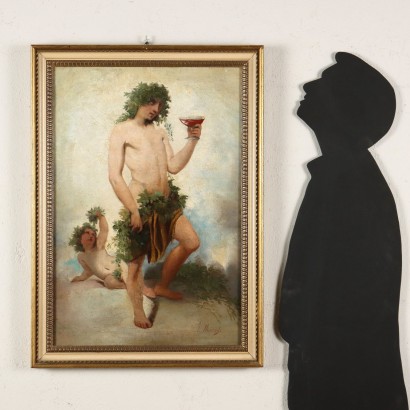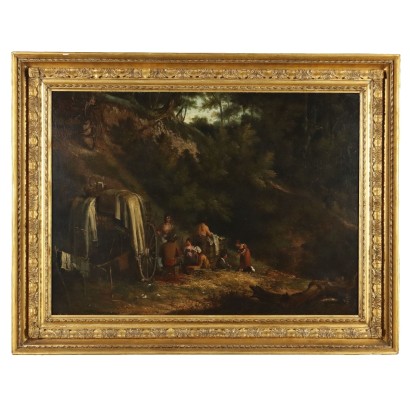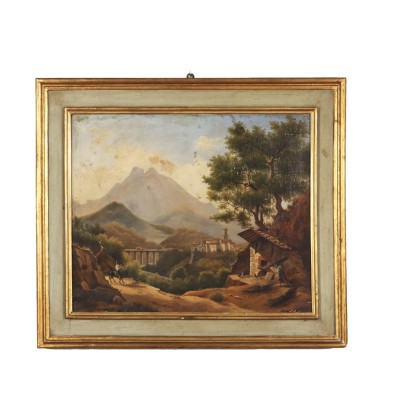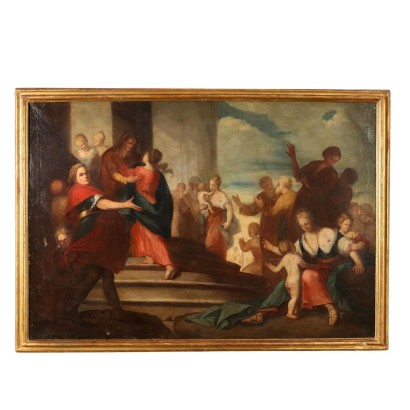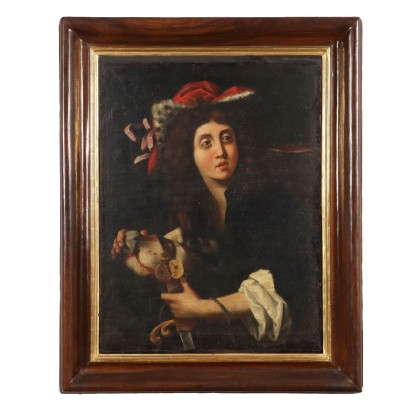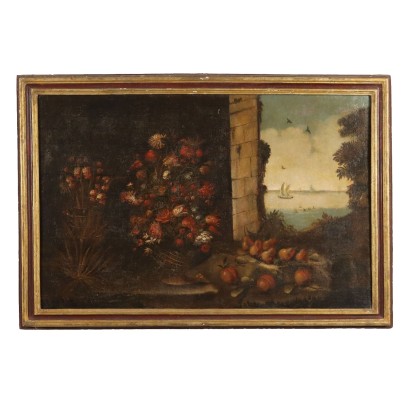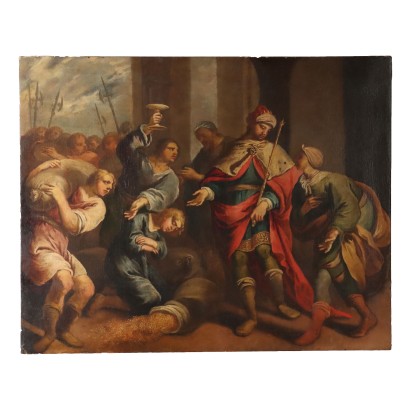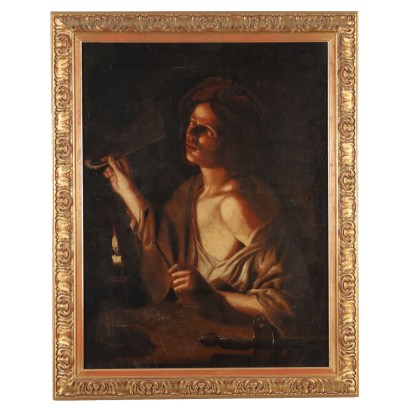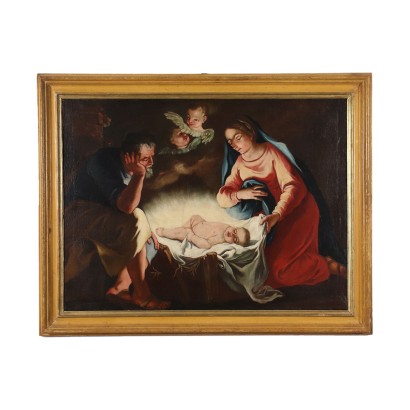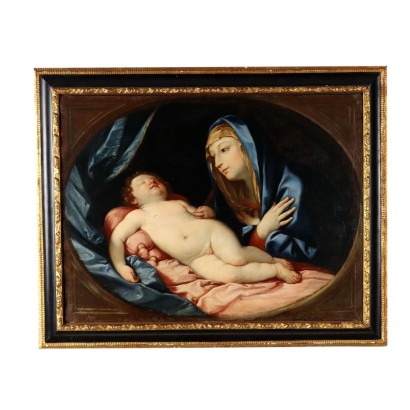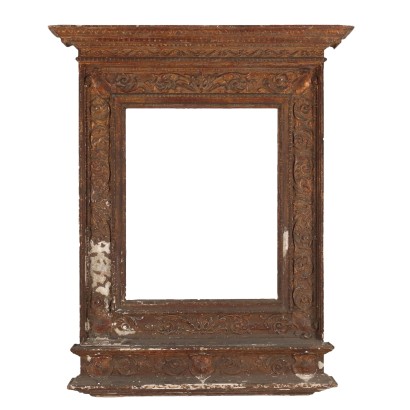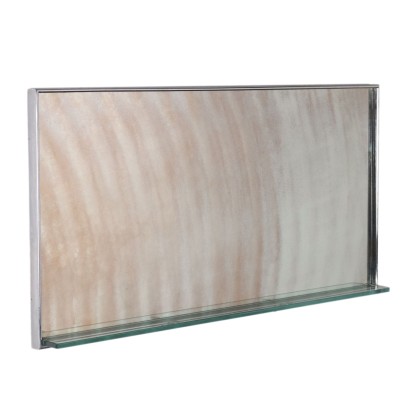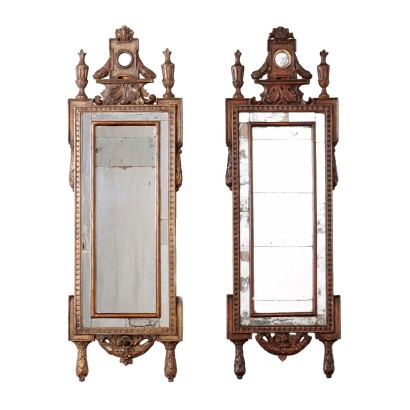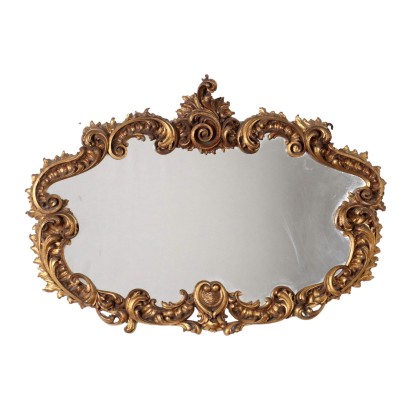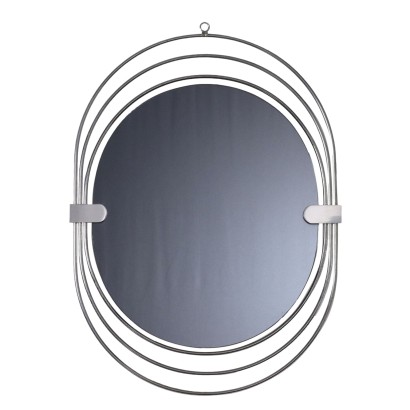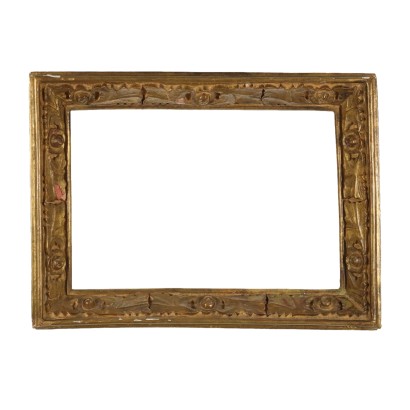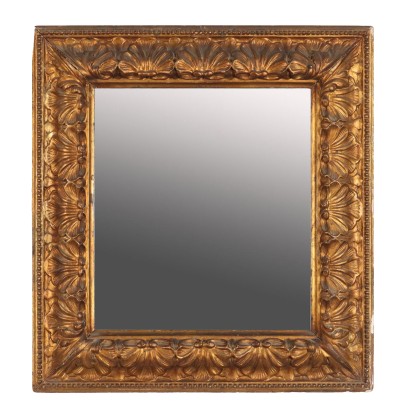Ancient Painting G. Muzzioli '800 Portrait Drunk Baccus Oil on Canvas - Drunk Baccus
Features
Drunk Baccus
Artist: Giovanni Muzzioli (1854-1894)
Artwork title: Bacco Ebbro
Age: 19th Century / 1801 - 1900
Subject: Portrait/Face
Artistic technique: Painting
Technical specification: Oil on Canvas
Description : Bacco Ebbro
Oil on canvas. Signed lower right. The god is depicted standing on the scene, clad only in a cloth around his loins and by ivy leaves placed on his hips and head, while holding a chalice in one hand; his gaze is vacant and dazed. Behind him, a semi-reclining putto plays with ivy. All around are white clouds, just as the ground is white, with flashes of blue sky and a green bush creating the only contrasts. On the back of the work is the label 'Mario Galli Collezione d'Arte', with cataloguing number 64 and the artist's autograph inscription. The work well represents the painting of this artist, who was born in Modena but trained artistically first in Rome and then in Florence, where he spent most of his life. His rich production initially proposed mainly historical subjects, but then turned to portraits and finally to landscapes. His uniqueness can be recognised in his ability to range from historical subjects, often placed in settings taken from ancient Pompeii, to the Macchiaioli-style naturalism of his second period, in which Muzzioli sought a significant perception of atmosphere and light in subjects inspired by the rural Tuscan environment, often set in antiquity. In this work, a portrait of a mythological character, the artist's luministic intent strongly transpires, the search for the effect of light playing on the naked bodies of the god and the putto, then fading into the background. The Art Gallery label leads back to the Florentine Mario Galli (1877 -1946), a sculptor who was also an important collector of works especially by Macchiaioli. The work shows an important crack and has been retouched. It is presented in a stylish frame.
Product Condition:
Product in good condition, shows small signs of wear. We try to present the actual condition as fully as possible with photos. If certain details are not clear from the photos, the description applies.
Frame Size (cm):
Height: 87
Width: 63
Depth: 5
Artwork dimensions (cm):
Height: 77
Width: 52
Additional Information
Artist: Giovanni Muzzioli (1854-1894)
Born in Modena on 10 February 1854, Giovanni Muzzioli entered the Academy of Fine Arts in his hometown in 1867, where he studied drawing and figure and followed the lessons of Mario Discovolo, who had introduced a new approach to naturalistic themes into landscape painting through the direct study of life, and those of Ferdinando Manzini, professor of decoration and set designer at the Teatro Comunale, from whom he learned compositional solutions and repertoires which soon proved to be useful for the mise en scène of his historical subjects. In 1872 he made his debut at the 1872 National Exhibition of Milan, winning the Poletti prize, which provided for a four-year study pensioner, for the first three years at the Accademia di S. Luca in Rome and for the last year in those of Florence or Venice. In 1873 he then moved to Rome, to the Accademia di San Luca, and in 1876 he moved to Florence, where he soon came into contact with the main exponents of Tuscan naturalism and macchiato painting; he intertwined relationships with the group of 'parionists and with the Florentine artistic circle (later CAF), then animated by Diego Martelli and Corrado Ricci. Attending this environment stimulated a reflection on the landscape, which was however initially outclassed by the success of the paintings of historical subjects, portraits and genre scenes with a Roman setting. At the Paris Universal Exposition of 1878 he deepened his reflection on so-called genre history painting, set in antiquity or in a pleasant and reassuring Empire environment, described with an archaeological sense and updated through an international figurative culture and a close dialectic between ideal and True. He actively participated in Florentine cultural life, also holding positions of representation and merit in the city's artistic associations. His works entered the most prestigious collections in the city. In the wake of Tuscan naturalism he turned to the representation of idylls and courtships in costume. After 1887 he exhibited only works inspired by ancient Rome in institutional exhibitions. Thanks to the support of the Florentine gallery owner Luigi Pisani, he obtained great recognition. Dating from the second half of the 1980s, alongside commissioned works with elegiac and gallant themes, also bourgeois interior scenes and scenes of daily life en plein air, in which the conquest of that luminosity already dear to the foreign market became dominant. It was particularly successful at the National Exhibition of Fine Arts in Bologna in 1888; in 1890 he collaborated together with other Florentine artists on the first illustrated edition of Le veglie di Neri by Renato Fucini (Ulrico Hoepli, Milan) and in 1891 he participated in the Exhibition of sketches at the Artistic Circle, which collected small-scale life studies inspired by life daily life: a genre that found its fortune, in Tuscany and beyond, for its extemporaneous and anecdotal character. In 1891 he was elected to the Giunta of Fine Arts at the Ministry of Public Education, working from 1893 on the commission for the purchases of the Modern Art Gallery in Rome. A large group of portraits dates back to this period. In 1893 he returned to Modena, where he died in August 1894.Age: 19th Century / 1801 - 1900
19th Century / 1801 - 1900Subject: Portrait/Face
Artistic technique: Painting
La pittura è l'arte che consiste nell'applicare dei pigmenti a un supporto come la carta, la tela, la seta, la ceramica, il legno, il vetro o un muro. Essendo i pigmenti essenzialmente solidi, è necessario utilizzare un legante, che li porti a uno stadio liquido, più fluido o più denso, e un collante, che permetta l'adesione duratura al supporto. Chi dipinge è detto pittore o pittrice. Il risultato è un'immagine che, a seconda delle intenzioni dell'autore, esprime la sua percezione del mondo o una libera associazione di forme o un qualsiasi altro significato, a seconda della sua creatività, del suo gusto estetico e di quello della società di cui fa parte.Technical specification: Oil on Canvas
The oil painting is a painting technique using powder pigments mixed with bases in inert and oils.Other customers have searched:
Arte ottocento, artisti italiani, dipinti 800, dipinto olio su tela, dipinto antico, dipinto paesaggio, dipinti natura morta, arte antica, dipinto olio su tavola..
Se sei un appassionato d'arte, non perderti i nostri approfondimenti sul Blog Arte Di Mano in Mano e su FineArt by Di Mano in Mano - Arte:
Ecco alcuni tra i principali articoli:
Vedute
Falsi nell'arte antica
Un messaggio di fiducia per ripartire
La potenza espressiva dell'arte figurativa etiope
Breve Storia del Collezionismo
Giorgio Upiglio, maestro dei libri d'artista
Matthias Withoos detto "Calzetta bianca"
San Rocco pensaci tu - Classic Monday
Dai un'occhiata alle nostre rubriche di divulgazione sull'arte:
Epoche
Lavorazioni e tecniche
Mostre ed Eventi
Protagonisti
Ti suggeriamo di guardare anche le presentazioni di questi dipinti ottocenteschi:
Tavoletta Porcellana Regina Luisa di Prussia, Berlino, Ultimo Quarto XIX secolo
Veduta di Frascati, Achille Etna Michallon, ambito di, terzo decennio XIX secolo, olio su tela
Venere Dormiente, Claudio Rinaldi, 1899
Sapevi che l'arte può essere anche un ottimo investimento (e non solo per grandi portafogli)?
L'Arte tra Collezionismo e Investimento
FineArt: Arte come investimento
Product availability
The product can be seen at Cambiago
Immediate availability
Ready for delivery within 2 working days from ordering the product.




